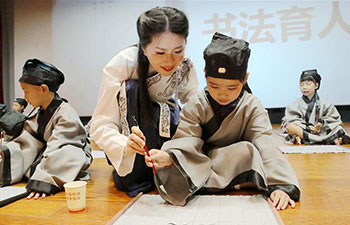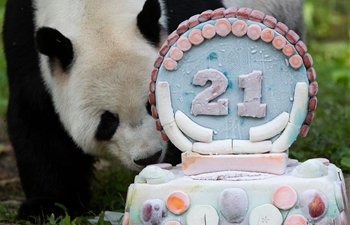by Raul Menchaca
HAVANA, Aug. 30 (Xinhua) -- Havana's annual carnival celebrations feature a steady parade of floats and dance troupes, but one in particular remains a crowd favorite after more than 100 years.
"Los Componedores de batea," as the troupe is known, turned 110 in 2018 and is still going strong, each year inspiring carnival revelers to sing and dance along.
Steeped in tradition, the troupe's theme is early 19th-century tenement life in Havana, and how the city's working-class residents overcame hardship with pluck and perseverance, as well as a good dose of humor.
No one could afford a washing machine, so tenement residents washed laundry in large round wooden buckets known as "bateas." The buckets were often in need of repair and the people whose job it was to fix them were known as "componedores de batea," which roughly translates into "bucket repairers."
Through their dance routine and vibrant costumes, the dancers, including several men dressed as women, tell the story of a tenement resident whose misfortune has a happy ending, as neighbors gather round and commiseration turns into celebration.
As the story goes, while washing clothes, the woman broke the wooden bucket she had borrowed, sparking a fight that turns into a fiesta after the jovial repairer arrives on the scene to put things right.
"That's how the dance troupe got its start in 1908," the group's current director, Javier Alba, told Xinhua as this year's carnival kicked off in mid-August.
The troupe's original director, Alfredo Mora, who was born in the poor Cayo Hueso barrio of central Havana, decided to parody the tenement life he grew up around by dressing men up as women carrying bateas.
Today Alba, a plastic surgeon at one of Havana's leading hospitals who dedicates his free time to the troupe, sees his pastime as a kind of cultural labor of love.
"We have rescued everything that was being lost along the way, recounting the history of the troupe, and that is how today we are a part of the Havana Carnival," said Alba.
"We are almost 200 people, including ... five men dressed up as large women with wooden buckets over their heads," Alba said, reenacting the story that inspired the original troupe. Alba has been directing the group for the past 12 years.
Like Alba, the dancers and musicians have regular jobs, but are involved in the troupe out of a passion for performing.
"Los Componedores" dress in the red, blue and white colors of the Cuban flag, making them a favorite of the audience, proud of their history and cultural heritage.
In recent decades, the troupe has been invited to perform abroad, and won many awards. In 2008, it swept up all the prizes of the Havana Carnival, including the best costume, best choreography, and the Grand Prize.
The troupe trains future generations of dancers by recruiting children for "Los Componedoritos de batea." In fact, Alba was one of these children, later joining the adult troupe and going on to become its choreographer and, after Villa's death, its director.
Every August, thousands of "habaneros" converge on the Malecon, the city's seafront promenade, for two consecutive weekends, to enjoy the pageantry and fun of carnival, and cool off from the summer heat.
"For us, the Havana Carnival is the culmination, the city's biggest celebration, and the largest stage to which we can bring all of this tradition," Alba said.













